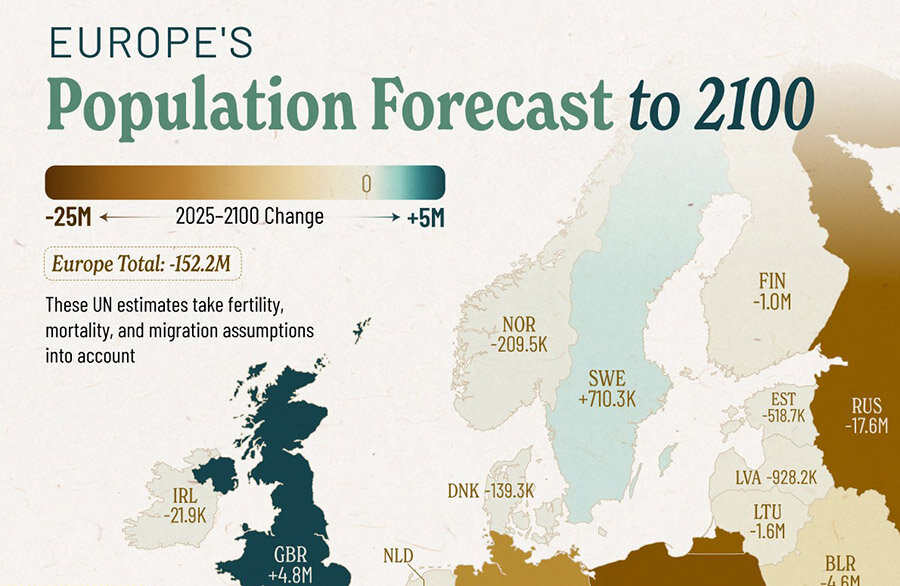читайте также
 Ten Years to a Passport: New Citizenship Rules in Portugal
Ten Years to a Passport: New Citizenship Rules in Portugal
 Top 25 World Economies 2025: Who Shapes Global Growth
Top 25 World Economies 2025: Who Shapes Global Growth
 “Season of Strict Rules”: How Cities Around the World Are Tightening Short-Term Rental Laws — And What It Means for Guests, Hosts, and Investors
“Season of Strict Rules”: How Cities Around the World Are Tightening Short-Term Rental Laws — And What It Means for Guests, Hosts, and Investors
 Turkey to Double the Tax Burden on Landlords
Turkey to Double the Tax Burden on Landlords
 Europe Calls — and Pickpockets Answer: Where Tourists Face the Greatest Risks in 2025 and How Not to Become a Victim
Europe Calls — and Pickpockets Answer: Where Tourists Face the Greatest Risks in 2025 and How Not to Become a Victim
 Thailand to Deport Russians and Crack Down on Visa Runners
Thailand to Deport Russians and Crack Down on Visa Runners

Visual Capitalist has published a UN-based forecast showing how Europe’s population will change by 2100. The report reveals that most European countries will face a sharp demographic decline, with population growth expected in only seven states.
Eastern and Southern Europe in Decline
The steepest declines are projected in Eastern and Southern Europe. Ukraine leads the negative forecast, with a potential 61% population drop by 2100. Albania and Lithuania follow (both -57%), then Bosnia and Herzegovina (-56%), North Macedonia and Belarus (both -52%). Other countries forecast to lose half their population include Latvia and Moldova. Poland (-49%), Bulgaria (-47%), Serbia (-45%), Croatia (-44%), and Romania (-43%) are also among the hardest hit.
Large population drops are also expected in Europe’s biggest economies: Germany (-13.8 million), Poland (-18.8 million), and Italy (-23.8 million). Eastern Europe’s demographic decline, ongoing since the 1990s, is set to intensify. By 2100, Russia and Ukraine could lose 40 million people combined.
This decline is driven by youth emigration, aging populations, and low birth rates—exacerbated by weak family support policies and limited employment prospects.
Growth in the West and North
In contrast, some countries—mostly in Western and Northern Europe—will maintain or grow their populations. Monaco is forecast to grow by 24%, Luxembourg by 10%, and Liechtenstein by 9%. Moderate increases are expected in the UK and Sweden (both +7%), France (+3%), and Switzerland (+2%). These countries benefit from higher birth rates, strong economies, generous family policies, and active migration programs.
Aging Populations: A Structural Burden
Europe’s aging population is a looming concern. By 2100, over 30% of EU citizens will be over 65. The old-age dependency ratio—retirees vs. working-age adults—will rise from 32 (2021) to 57 (2100), placing immense pressure on healthcare systems and economic productivity. Countries with sharp imbalances will face declining labor forces and rising fiscal burdens per worker.
Global Context and Migration Dynamics
While Europe shrinks, Africa’s population is projected to boom, reaching over 4 billion people by 2100—about 38% of the world’s total. This demographic contrast is expected to fuel migration flows toward Europe, which may increasingly struggle with labor shortages.
Supporting data from World Population Review suggests similar patterns. Bulgaria is forecast to shrink 22.5% by 2050, followed by Lithuania (-22.1%), Latvia (-21.6%), and Ukraine (-19.5%). Serbia, Bosnia and Herzegovina, Croatia, and Moldova also face severe losses. Even countries like Japan and Albania are listed among high-risk nations.
Potential Solutions
To mitigate the crisis, experts suggest boosting birth rates and embracing immigration. Countries with strong social safety nets and migration policies may recover more effectively. Analysts agree that with proactive reforms—supporting families, integrating older citizens, and modernizing social systems—the impact of Europe’s demographic decline can be softened. The crisis also opens opportunities for innovation in economic and social planning.





